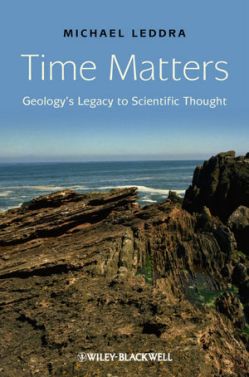
TIME MATTERS – GEOLOGY’S LEGACY TO SCIENTIFIC THOUGHT
MICHAEL LEDDRA
Published by: Wiley-Blackwell Publication date: 2010. ISBN: 978-1-4051-9909-4 288pp. List price: £24.95 (pbk); £75.00 (hbk) www.wiley.com/wiley-blackwell
The title of Michael Leddra’s book may have seemed an incongruous choice of holiday reading during a time, last summer, when for me, time really didn’t matter! But I was far from disappointed. Time Matters takes the reader through a comprehensive synopsis of the topic; through rock dating and time scales, plutonism and neptunism, uniformitarianism and catastrophism, evolution and creationism, and onto continental drift and plate tectonics. Each concept, set into its own historical timescale, details the development and discoveries that have shaped our understanding of geological time, by the people most notably involved.
Time Matters is more than a textbook and reads with the accessibility of a novel. Clearly written by an educationalist, the reader’s own understanding is frequently challenged with appropriate use of “discussion point questions” which make the text much more interactive. The author also provides additional background to the topics discussed as well as further reading suggestions. Indeed, he frequently quotes from an extensive bibliography that further directs the reader to new ideas for study, and it is this synthesis of so many current books on this topic that makes
Time Matters such a useful publication. Thus the book, which is liberally illustrated with black and white photos, maps and diagrams and a very good index, is an ideal introduction to a topic that is central to any study of the earth sciences.
This is certainly appropriate for the A-Level/first year university market and as a background to the development of understanding of the earth sciences for the educated layman. As the book covers so many important topics - remnant magnetism, geological principles, radiometric dating techniques and mountain building to name but a few - the A-Level student and Year 1 undergraduate will find it a particularly useful reference. Whilst the cost may be prohibitive for school class copies, this is certainly one for the departmental and main library. I thoroughly recommend the paperback version of the book to colleagues and students alike - you will not be disappointed.
Reviewed by Pete Loader, St Bede’s College, Manchester